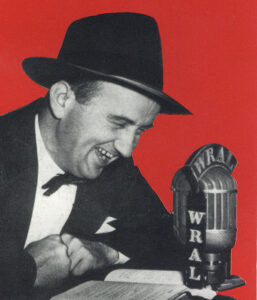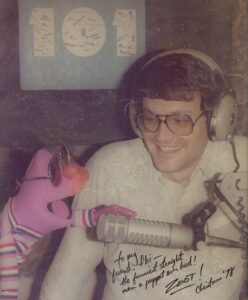
September 6, 1946. That is the day WRAL-FM joined big brother WRAL-AM on the radio. To get the full scoop on how WRAL-FM came into being, we turn to Fred Fletcher’s book, TEMPUS FUGIT to get the facts and a bit of frivolity. And it all started with the FCC granting CBC a license to operate WCOY-FM. Yep, those were the call letters issued by the FCC to the second FM station licensed in North Carolina. How kooky was that?
Excerpts from Tempest Fugit, Chapter 13, “Reaching Out”
 Fred Fletcher
Fred Fletcher
By the mid-1940s we had firmly established our niche in the Raleigh Market. WRAL was a successful radio station, and we were all making a living. That, however, did not keep us from looking for other ways to reach out to the listening public. We were still a 250 watt station in a market dominated by a 50,000 watt station.
In the years following the war, we found two good opportunities to expand our listening audience, our services, and our income. The first was frequency modulation or FM broadcasting. The second was the Tobacco Network.
FM broadcasting is so common today that you forget that twenty years or so ago, it was AMs smaller, younger, and not so profitable step-sister. In 1970, roughly three-quarters of the audience in most parts of the country was still listening to AM. And we had ordered equipment for FM operations twenty-five years before that.
There were, in those days, people with the FCC who hinted that, if you wanted a big signal, FM was the way to go. We could – and did – get a license for a 100,000 watt FM station. The only problem was that almost no one had an FM receiver. Most home radios were AM only. And in those days when a car radio was truly an option, those that had radios had AMs. So, it could be a case of having a 100,000 watt signal to nobody!
In 1946, it was like the story of the chicken and the egg. Nobody wanted to buy an FM receiver because there were few FM stations in the country, only one in North Carolina, and none in the Raleigh market. On the other hand, you wanted to think long and hard before you put a substantial amount of money into a radio station that nobody could listen to.
However, in 1946, after thinking long and hard, we decided that we had enough money to do it. We threw the switch on September 6, and WRAL-FM was on the air.
Then we went to work, trying to build an audience. I became a missionary for FM radio, sponsoring demonstrations with radio distributors and dealers. We even stocked and sold Pilot FM tuners from the station. To gather FM statistics, Scottie Stephenson and the rest of the station staff would go through the parking lots, looking into cars and noting what station their radio was tuned to and whether the car had an AM/FM radio.
We didn’t really think much about opening somebody’s car door and looking in until George Hall ran into a woman who didn’t think much of the idea either. She screamed at George that he was in her car, so George sensibly got out. Then she started chasing him, trying to hit him with her umbrella. George swore that the only thing that saved him was a city bus that pulled up and opened its door.
We also went around to auto dealers, encouraging them to push AM/FM combinations in new cars, and we backed that up with spots over the air, urging people to buy AM/FM receivers, “not half a radio, with AM only.”
Because FM reception was better than AM during thunderstorms and seldom had channel interference, we came up with a special summer promotion promising “static-free high fidelity reception” of FM programming.
At first, programming wasn’t a lot to brag about. We carried most of the same programs that we carried on WRAL-AM. But we knew that if we were going to build a real audience, we had to provide the FM listener with something they couldn’t get on AM. For instance, we broadcast the state’s Class C baseball playoffs in 1946, and we broadcast eight local high school football games that same fall. Then, we lined up more than 30 Big Four basketball games. (For non-North Carolinians, the Big Four are the University of North Carolina, North Carolina State, Duke University, and Wake Forest.)
We also stuck our FM nose into government or politics. We broadcast a daily legislative report gathered and announced by Tom Bost, a Greensboro Daily News reporter covering the state government. We also made available to Governor Kerr Scott – in the somewhat pompous language of the press release – “the full facilities of the Dixie FM network” whenever he wanted to talk to the people. Not mentioned in the release, nor promoted, was the fact that we also put a few AM stations on the network so that Governor Scott would have somebody to talk to.”
There is more to Fred’s story about the beginnings of WRAL-FM, but we know how the story turns out. WRAL became a hit through the decades.
 Famous Bob Inskeep with side-kick Zoot.
Famous Bob Inskeep with side-kick Zoot.
In the 1970s WRAL-FM adopted the “Adult Contemporary” musical format and eventually branded itself “MIX-101.5.” Morning host Bob Inskeep was one of the station’s most popular and successful personalities. Inskeep joined WRAL-FM in 1974 and won legions of fans during a fifteen-year CBC career.
Inskeep was followed by Bill Jordan, who teamed with a number of co-hosts to carry on the station’s morning show success. Jordan retired in 2013 after 23 years as the best known “voice” of the station.
Through the years WRAL-FM has continued its commitment to technological innovation and excellence. In December 2002, it became one of the country’s first licensed commercial radio stations to broadcast in HD Radio, which allows it to split the radio signal into multiple program streams.
WRAL-FM has also received numerous honors for its community service, news reporting and public affairs programming.
In 1983 WRAL-FM and its corporate partner North Carolina News Network won the coveted George Foster Peabody Award for a series of reports focusing on victims across all walks of life.
In 1996 the station won the prestigious NAB Crystal Award for Excellence in Community Service. The NAB judges lauded WRAL’s fundraising for victims of the Oklahoma City bombings, support of Duke Children’s Hospital and a host of other community projects benefitting needy citizens. Thirteen years later – in 2009 – the NAB once again honored WRAL-FM with the national Crystal Award, citing the station’s numerous efforts in the community.
WRAL-FM’s best known community service project began in 1994 as a fundraising effort for Duke Children’s Hospital. The station’s annual “Radio-Thons” have raised more than $15 million in the years since.
At WRAL- FM…the beat literally goes on!
Thanks to Corp’s Pam Allen for this capcom story & these photos. Pam Parris Allen is a former WRAL newscast producer/director who now works as a researcher and producer on the CBC History Project.
Fred Fletcher
J.D. Lewis, first African-American radio announcer in NC
Famous Bob Inskeep with side-kick Zoot.
WRAL-FM News department, led by Bill Leslie (holding plaque), wins the Peabody Award.
WRAL-FM’s Toys for Tots Christmas Campaign
Duke Children’s Miracle Network
Bill Jordan WRAL-FM
Kyle Smelser, Sarah King, Bryan Lord – “Two Men and a Mom”